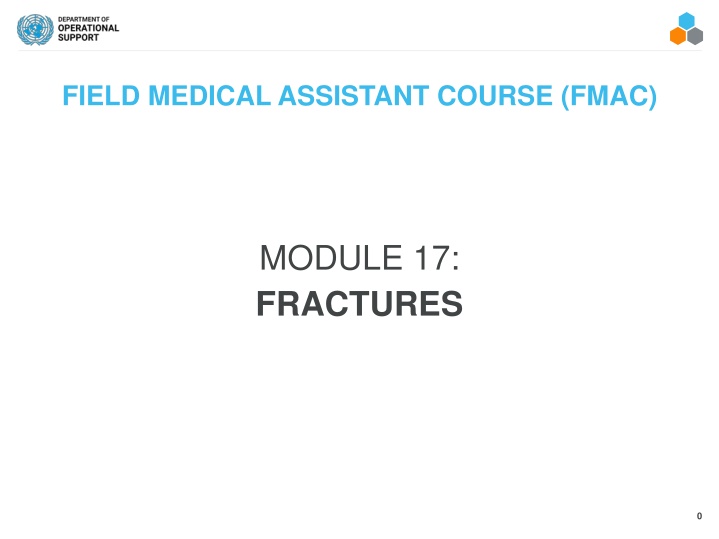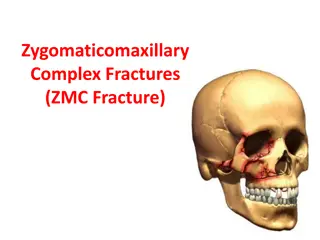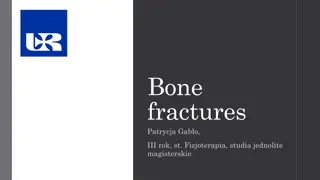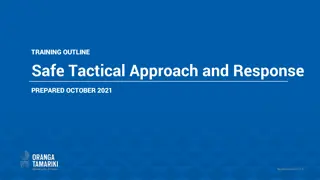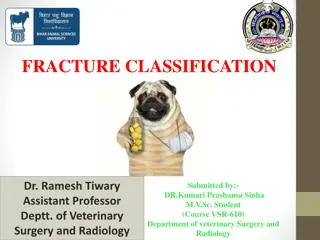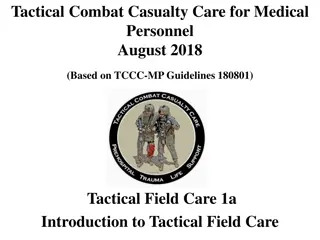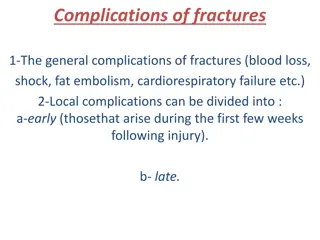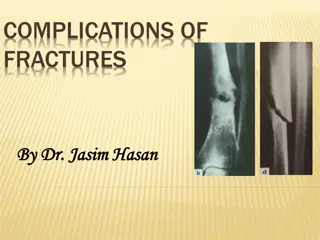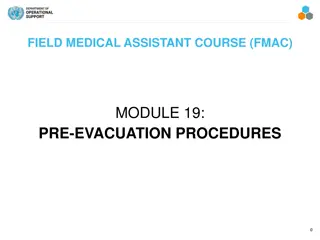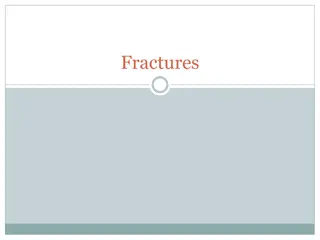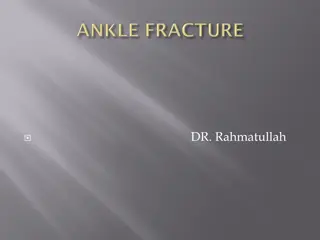Tactical Field Medical Assistant Training - Fractures Assessment and Management
Explore the Tactical Field Medical Assistant Course training modules focusing on fractures assessment and management. Learn to identify fracture warning signs, differentiate between closed and open fractures, and demonstrate proper splint application. Gain knowledge on caring for fractures in tactical field care scenarios following TFMA guidelines. Dive into the phases of TFMA, including care under fire, tactical field care, and tactical evacuation care, emphasizing quick decision-making and deliberate assessment of injuries. Enhance your skills in dealing with life-threatening situations, massive bleeding, and prioritizing care during tactical field operations.
Download Presentation

Please find below an Image/Link to download the presentation.
The content on the website is provided AS IS for your information and personal use only. It may not be sold, licensed, or shared on other websites without obtaining consent from the author.If you encounter any issues during the download, it is possible that the publisher has removed the file from their server.
You are allowed to download the files provided on this website for personal or commercial use, subject to the condition that they are used lawfully. All files are the property of their respective owners.
The content on the website is provided AS IS for your information and personal use only. It may not be sold, licensed, or shared on other websites without obtaining consent from the author.
E N D
Presentation Transcript
FIELD MEDICAL ASSISTANT COURSE (FMAC) MODULE 17: FRACTURES 0
TACTICAL FIELD MEDICAL AID (TFMA) ROLE-BASED TRAINING SPECTRUM ROLE 1 CARE NONMEDICAL PERSONNEL Buddy First Aid Field Medical Assistant You are HERE MEDICAL PERSONNEL Paramedic Nurse Doctor 1
STUDENT LEARNING OBJECTIVES TERMINAL LEARNING OBJECTIVE T19 Given a combat peacekeeping or non-combat peacekeeping scenario, perform assessment and initial management of fractures during Tactical Field Care in accordance with TFMA Guidelines EO86 Identify signs of a suspected fracture EO87 Demonstrate the basic care of fractures in accordance with TCCC Guidelines EO88 Demonstrate proper splint application using a malleable rigid or improvised splint to a suspected fracture in Tactical Field Care 2
Three PHASES of TFMA 1CARE UNDER FIRE 2TACTICAL FIELD CARE 3TACTICAL EVACUATION CARE RETURN FIRE AND TAKE COVER COVER AND CONCEALMENT Quick decision-making: Consider scene safety Identify and control life- threatening bleeding Move casualty to safety Basic Management Plan: Maintain tactical situational awareness Triage casualties as required MARCH PAWS assessment More deliberate assessment and treatment of unrecognized life- threatening injuries: Pre-evacuation procedures Continuation of documentation NOTE: This is covered in more advanced TFMA training! YOU ARE HERE 3
TACTICAL FIELD CARE MARCH PAWS DURING LIFE-THREATENING AFTER LIFE-THREATENING MASSIVE BLEEDING #1 Priority PAIN AIRWAY ANTIBIOTICS RESPIRATION WOUNDS CIRCULATION SPLINTING HYPOTHERMIA / HEAD INJURIES 4
FRACTURES ASSESS FOR A FRACTURE WARNING SIGNS OF A FRACTURE: Significant pain and swelling An audible or perceived snap Different length or shape of limb Loss of pulse or sensation in the injured arm or leg Crepitus (hearing a crackling or popping sound under the skin) CLOSED FRACTURE No open wound (break in skin) for closed fracture OPEN FRACTURE Open fracture open wound (break in skin) major threat for infection 5
FRACTURES OBJECTIVES OF SPLINTING A splint is used to prevent movement and hold an injured arm/leg in place to: 1. Identify the location of the fracture NOTE: Have the casualty or someone else manually stabilize the area 2. Check the distal pulse (pulse below the fracture) and capillary refill (color returning to the nail bed after pressing on it) on the injured extremity before applying the splint 3. Prepare the splint materials for application NOTE: Measure and shape the splint on the opposing uninjured extremity 4. Prepare securing materials (cravats, elastic wraps/bandages, etc.) 5. Apply the splint to the injured extremity with the limb, in the position of function (a normal resting position), if possible NOTE: If possible, lightly pad all voids within the splint to make it more comfortable 6. Secure the splint in place with appropriate materials 7. Ensure the joints above and below the fracture are immobilized in the splint whenever possible 8. Recheck the distal pulse following application of the splint. If the pulse is not palpable, loosen the splint, reposition, and reapply the splint 9. Refer to the Medic to administer the pain medications (from the Wound Medication Pack) as needed and the antibiotic for any open fracture(s) 10. Document all treatment on a Casualty Card and attach it to the casualty 6
FRACTURES PRINCIPLES OF SPLINTING Check for other associated injuries Use malleable or rigid materials Try to pad all voids or wrap if using rigid splint Secure splint with elastic bandage, cravats, belts, tape Try to splint before moving the casualty Minimize manipulation of the extremity before splinting Incorporate one joint above and below the fracture Splint arm fractures to the shirt using the sleeve, if needed Check distal pulse and skin color before and after splinting 7
SPLINTING THINGS TO AVOID WHEN SPLINTING Manipulating the fracture site too much resulting in pain, additional damage to blood vessels and nerves, etc. Securing too tightly, cutting off blood flow Failing to immobilize joint above and below fracture when possible Causing further injury Making casualty uncomfortable during transport/evacuation Splinting near or over a wound that has not be properly treated 8
SPLINTING GUIDELINES FOR LEG SPLINTS Identify the location of the fracture Before applying the splint, CHECK distal pulse (pulse below the fracture) CHECK capillary refill (color returning to the nail bed after pressing on it) on the injured extremity before applying the splint Have the casualty or someone else manually stabilize the area 9
SPLINTING GUIDELINES FOR LEG SPLINTS PREPARE the splint materials for application PREPARE securing materials (cravats, elastic wraps/ bandages, etc.) APPLY the splint to the injured extremity with the limb, in the position of function, a normal resting position, if possible Measure and shape the splint on the opposing uninjured extremity 10
FRACTURES GUIDELINES FOR LEG SPLINTS ENSURE the joints above and below the fracture are immobilized in the splint whenever possible RECHECK the distal pulse following application of the splint If the pulse is not palpable, loosen the splint, reposition, and reapply SECURE the splint in place with appropriate materials 11
SPLINTING GUIDELINES FOR ARM SPLINTS Splinting the arm is the same concept as splinting a leg with the following exceptions: If possible, have casualty support their injury while preparing equipment Use two triangular bandages to secure limb to body Use third triangular bandage; place under injured arm and around neck to help support injured limb Mould padded splint using casualty s unaffected limb 12
SPLINTING GUIDELINES FOR ARM SPLINTS Apply a swathe to immobilize the upper arm Place two cravats above the fracture site and two below the fracture site (preferred) Check for signs of impaired circulation Apply a sling to immobilize the forearm 13
SPLINTING AN ARM SPLINTING (TACTICAL FIELD CARE) Video can be found on DeployedMedicine.com 14
SKILL STATION Splinting (Skill) Splinting 15
SUMMARY The most important aspect of splinting is to splint in a way that does not harm the nerves or blood vessels in the splinted extremity Before and after splinting, assess the following: CIRCULATION Check pulses distal to the splint (between splint and end of limb) MOTOR Ask the casualty to move the body parts distal to the splint, e.g., fingers or toes SENSORY See if the casualty can feel a gentle touch on the body parts distal to the splint AFTER SPLINTING Document all assessment and treatment on the Casualty Card 16
CHECK ON LEARNING True or False: When applying a splint, ensure the joints above and below the fracture are immobilized in the splint whenever possible. What should you assess before and after splinting? 17
